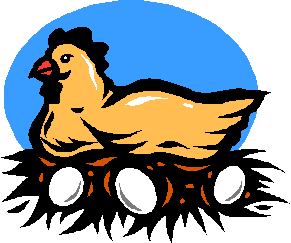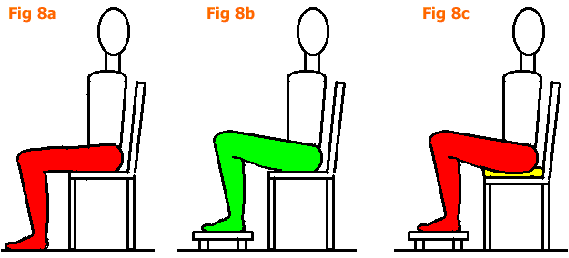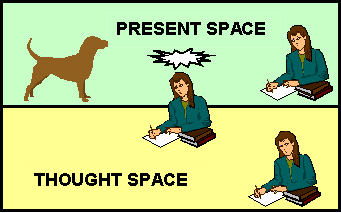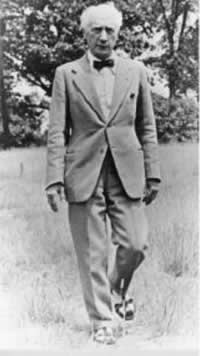| 7. CORRECTING YOUR
POSTURE:
Yoga, the Alexander Method of posture correction, Osteopathy and
Chiropractics can help you to improve your posture. The first two
involve learning to use your body in a better way, while the last
two depend on external manipulation.
Let us however look at the problem from an Engineering
perspective. There are 206 bones in the human body and more than 600
muscles; these interrelate with one other in complex ways. Clearly,
posture cannot be corrected the way in which you would repair a
motorcar. Since the problem is mechanically very complex it is
necessary to evolve simple principles which will help the body to
naturally go back to its correct alignment.
It is useful to keep in mind, as we attempt to correct our
posture that all humans have precisely the same number of bones and
muscles in their bodies. If one person moves more gracefully than
another, or he looks better proportioned, it may not all be due to
any major difference of equipment, but rather the way in which the
equipment is used.
7.1 STRATEGY FOR CORRECTING POSTURE:
 |
Fig 7. Correcting posture has three important aspects:
- MECHANICAL ASPECT
- MENTAL ASPECT
- BEHAVIORAL ASPECT
|
The Mechanical aspect can be split as follows:
- PHYSICAL ENVIRONMENT
- BALANCING POSTURE
We can put together the individual activities and prioritize
them:
- PHYSICAL ENVIRONMENT
- MENTAL ASPECT
- BALANCING POSTURE
|
 |
7.2 PHYSICAL ENVIRONMENT:
- CLOTHING
- FOOTWEAR
- CHAIR
- SOFT SURFACES
- TAKING EXERCISE
7.2.1 CLOTHING ……………
And the Lord God called unto Adam, and said unto him, where art
thou? And he said, I heard thy voice in the garden, and I was
afraid, because I was naked; and I hid myself. And he said, Who told
thee that thou was naked? Hast thou eaten of the tree, whereof I
commanded thee that thou shouldest not eat?
……….. The Bible, Genesis 3:9,10,11
The instinct to cover the naked body has prompted all cultures to
tie something or the other around the waist. Humans (Proto-humans)
could have started to tie things around their waist as long as 2
Million years ago! Tying anything around the waist will however
prevent proper functioning of the stomach muscles. For girls and
women therefore the best items of wear are frocks and gowns. Skirts
and saris are not advisable unless you can find some way to suspend
them from the shoulders. For boys and men, shorts and trousers,
which are loose around the waist and suspended from the shoulders,
are best. Anything tied around the waist, even loosely, like dhoti
and pyjama will create problems. Pyjamas should also be suspended
using shoulder straps. Modern V type underwear, with soft elastic
that grip the pelvic bone are OK. The important thing to remember is
that we are not born with our clothes on and no animal other than
ourselves wear clothes. Clothing should not inhibit movement of the
body. If the musculoskeletal system is inhibited in any way, at any
location, it will upset the postural balance of the whole body.
7.2.2 FOOTWEAR …………
Improper footwear will cause major problems. The best thing to
wear is leather slippers with thin soles, in which the soles, both
where they come in contact with the feet and where they come in
contact with the ground are perfectly flat. We will find invariably
that slippers available in the market have heels. It is important to
have the heels removed. It is more difficult to find suitable shoes:
shoes may severely restrict freedom of movement of the feet and thus
affect posture. Hawaii slippers provide tremendous freedom of
movement, hence they are recommended – a firm material such as
leather is however better than rubber which provides cushioning.
Proper gait is a complex wave like motion starting at the feet.
Improper footwear will alter this gait.
7.2.3 CHAIR ………..
The thighbones are attached to the pelvic bone by means of ball
joints and actuated by very complex arrangement of muscles. It is
very important to sit in such a way that the freedom of movement at
this joint is not seriously compromised. When sitting in standard
chairs you are effectively sitting on the muscles which move the
thighs, thus severely restricting their freedom of movement, Fig 8a.
The problem can be solved by sitting on chairs and benches, which
are lower, or by using footrests, Fig 8b. It is better to sit on
hard surfaces rather than on cushioned surfaces.
 |
| Fig 8a: In a standard chair the thighs make
intimate contact with the chair, inhibiting free movement of
muscles. Fig 8b: By limiting contact of the thighs with the
chair the legs can be made more active and postural balance
can be achieved. Fig 8c: Soft cushions will prevent free
movement of muscles. |
7.2.4 SOFT SURFACES …………..
Our ideas about comfort are closely associated with soft
surfaces. Excessively cushioned surfaces on chairs, shoes, bed,
pillows etc. however will inhibit use of muscles and prevent them
from achieving postural balance (Fig 8c). Use of hard or firm
surfaces will help to keep muscles active and thus promote good
health.
7.2.5 TAKING EXERCISE ………..
Taking exercise and improving posture are basically incompatible.
Small children and animals do not take exercise, they play, they are
active and maintain superb postural balance: they are much healthier
than human adults. When exercise is heavy it is impossible to ensure
that all the muscles will be exercised uniformly: because of this,
different persons doing the same exercise can end up with markedly
different results. Walking is perhaps the best physical activity to
keep us fit; it should not be viewed as an exercise, rather it
should be interwoven in the fabric of our daily life. Exercising
with anything tied around the waist and while wearing faulty
footwear will distort posture. (When exercising or doing heavy
physical work we should also try to be in present space – see
below)
|
SCIENTIFIC BASIS FOR
TAKING EXERCISE
It is difficult to establish a scientific basis for
taking exercise, especially heavy exercise. From an
engineering perspective, if a structure is distorted
(Fig 6), it is necessary to remove the distortion. You
never load a deformed structure!
Doing exercise with clothing and footwear, which are
likely to distort the muskuloskeletal system, is equally
questionable. In Greece, where the Olympics first took
place, participants did not wear clothes! (Women were
not invited to these events.) Perhaps, they understood
human posture better than we
do.
| |
7.3 MENTAL ASPECT
There are 206 bones in the human body and more than 600 muscles,
it is impossible for us to figure out consciously how to hold them
all in a proper way. Only the subconscious mind can accomplish this
difficult task. To improve our posture therefore we have to
periodically move into PRESENT SPACE. Using this principle we can
begin to understand why small children and animals naturally
maintain good posture, and why for human adults it presents a
difficult task. Moving into present space is simply seeing things
around you sharply and clearly…
The principle can be explained by a simple experiment, which does
not need any tools. Become fully conscious of your immediate
surroundings by looking at things sharply and clearly – the
beautiful painting on the wall, the floral designs on the curtains,
the walls of the room, the books on the table, the beautiful green
of the lawn outside. Don’t strain to see any particular object –
keep the eyes relaxed by moving gently from one object to another.
Next, while looking clearly at external objects think of
something – anything. Perhaps the pleasant holiday you spent last
summer. Or try to conjure your wife’s / husband’s face. What
happens? When I persuaded a few friends to try this experiment, not
one was able to think in any way when he was fully focused on his
surroundings – it is in effect an animal state, of becoming one with
the environment. If you try to force yourself to think while holding
on to the images of your surroundings, the eyeballs are put under
severe strain as they try simultaneously to turn outwards (towards
the surroundings), and inwards (towards a thought or mental image).
Hence we can form a principle:
YOU CAN’T BE FULLY CONSCIOUS OF YOUR SURROUNDINGS AND
SIMULTANEOUSLY ENGAGE IN A PROCESS OF THOUGHT.
 |
Fig 9: Experience tells us that animals can
occupy only Present Space, while Humans can occupy Present
Space, Thought Space or a Space
in-between.
|
The concept is explored further in Fig 9. The space in which the
brain can wander (when the subject is awake and alert) can be
divided into two parts, Present Space and Thought Space – the two
separated by a barrier. Observations of animals suggest that they
are always alert to what is happening around them, they are never
‘lost in thought’ in the human sense. Hence it can reasonably be
assumed that they can occupy only Present Space – the construction
of their brain does not permit them to do otherwise. Human beings,
on the other hand, can occupy Present Space, Thought Space or a
Space that is in-between the two. For occupying an intermediate
state a price has to be paid in the form of increased physical
tension, which is first felt in the eye-balls and from there, the
rest of the body.
In the Alexander method of posture correction two complementary
principles are used which achieve the objective of bringing the mind
to present space in different ways. The first is the principle of
INHIBITION in which you are advised to inhibit your movements, that
is, let us say you are reaching for a book, you should deliberately
pause for a fraction of a second before you start your movement. The
pause will make you focus on the task at hand.
The second principle is AVOIDING AN END GAINING APPROACH. Let us
say you are driving a car, you are late and in a hurry to reach the
railway station. If you keep worrying about missing the train, your
muscular coordination will automatically become faulty. On the other
hand if you say to yourself OK it does not matter whether I catch
the train or not, your muscular co-ordination will improve, you will
be less likely to involve yourself in an accident, you will enjoy
your drive to the station and probably reach there sooner.
Good posture can be defined only when we are in present space.
When we are thinking our posture will automatically become faulty!
It is important to move into present space at periodic intervals to
keep us healthy and also to improve our mental functioning. Both,
the human body and mind work better in the subconscious state.
|
IMPROVING PERSONAL
RELATIONS
Moving into present space will help improve our
personal relations. In this state we can make eye
contact, and judgment of others, which vitiate many
relationships will be temporarily
suspended. | |
7.4 BALANCING POSTURE
 |
| Fig 10: A balanced system is easy to oscillate
too and fro. |
Balancing posture is very similar to balancing weights using a
weighing balance, Fig 10. Discovering how the large number of bones
and muscles in the body are linked is however not easy. To balance
posture we must not lock our bodies externally or internally.
Crossing one leg over the other when sitting down, crossing hands
over the chest and passing the weight of the upper body through the
arms when sitting next to a table are all examples of external
locking of the musculoskeletal system. The body should be held
symmetrical and the weight of the body should be passed to the
ground uniformly on both the legs – the woman in the plaque fixed on
the Voyager spacecraft is striking an attractive pose, but
supporting the weight of the body mainly on one leg is a form of
external locking, which provides poor postural balance. Even using
the backrest when sitting in a chair, which will prevent proper use
of a large number of muscle groups, can be conceived as external
locking.
Internal locking is when joints are held at their extreme
position. For instance the knees should always be slightly flexed to
keep all the muscles active. If the knees are moved to an extreme
position many muscles will have no work to do. Just as a shark must
swim continuously in order to breathe, so also, we must balance our
posture continuously to maintain the shape of the body.
When balancing our posture we have to minutely adjust the
musculo-skeletal system to get a feeling of strength and flexibility
over the whole length of the body. We must rediscover the contour of
the spine and we must be able to flex it, somewhat the way in which
a snake slithers on the ground. We must attempt to poise the head
gracefully and strongly over the spine. (Postural balance is easier
to feel out early in the morning in bed, after a good night’s sleep;
make sure your pillow elevates the head by no more than 2.5 cm, so
that the natural curvature of the spine is maintained). The girl in
(Fig 11) has good postural balance, observe that she is very much in
present space.
 |
Fig 11: Child demonstrating good postural
balance. (From The Alexander Principle by Dr. Wilfred Barlow).
|
Balance is a fundamental concept in Engineering. Many stationary
systems and practically all systems that move must be balanced to
function properly. The concept of balance is important for the
following reasons:
- Posture can only be corrected by trial and error. By keeping
this concept in mind we can avoid going dramatically wrong.
- It helps explain why 99% of adults will have postural faults.
A concept of balance (lacking in our environment and social
interactions) is required to integrate the musculoskeletal system.
- The concept of balance provides a suitable guideline for the
science of ergonomics. The dress we wear, the footwear and the
design of our physical environment must ensure that we are able at
all times, to keep the whole body in balance.
7.5 BEHAVIORAL ASPECT
 |
Fig 12: Fredrick Matthias Alexander,
(1869-1955), developed the Alexander Method of posture
correction, achieving in the process, deeper insight into the
problem of faulty posture than any one before him. He
discovered the very important principle, USE AFFECTS
FUNCTIONING, known as the Alexander Principle.
|
The Alexander Principle states that ……
USE AFFECTS FUNCTIONING
Because correcting posture is difficult we have to try to
maintain good posture at all times, this is in marked contrast to
the concept of taking exercise, where we exercise for say half an
hour and then use the body carelessly for the rest of the day.
Considerable organic changes have to take place in the muscular
system before good posture can be achieved. These changes will take
place in the positive direction only if we try to maintain good
posture at all times.
|
IN DR. BARLOW’S MEMORY
Individuals closely associated with the Alexander
Movement have informed me that the Alexander Principle
was actually coined by Dr Barlow, even though he himself
calls it the Alexander Principle.
To commemorate Dr. Barlow’s memory - he has
contributed a great deal to the understanding of Human
Posture - let us agree to call this principle the
Alexander/Barlow Principle.
| |
(The Alexander/Barlow Principle is a very important concept. It
is a concept we can use in other ways to enrich our lives )
7.6 SAFETY PRECAUTIONS
- The musculoskeletal system is enormously complex. If your
posture is already good, you are lucky. If you have to correct
your posture you are taking on a difficult task. It is best to
start by paying attention to your ‘Physical Environment’
- Parents should protect the posture of their children by paying
attention only to the ‘Physical Environment’. Consciously
correcting posture should be delayed till after the age of 20.
- In the process of correcting posture it is likely that you may
feel dizzy at times or you may have a muscle pull (when muscles
not used for a long time suddenly come into play). If there is any
physical distress do not make any sudden movement and move into
PRESENT SPACE. Your subconscious mind will know how to protect
you.
- It is not possible to maintain good posture if you are
mentally agitated. Personal worry should be converted into plans
of action so that you can focus on the work at hand.
- You should feel very comfortable in Present Space, if there is
any feeling of discomfort it will be because of the following
reasons. a) Your mind has blanked out – you are not thinking of
any thing, neither are you focused properly on the surroundings.
This is a very disorienting state. b) You are not able to suppress
your thoughts – if you are worried about something you will find
it difficult to move into present space c) you are trying too hard
– being in present space is a natural state!
- When you are tired your posture will become faulty. Lying down
for 5 to 10 minutes will rejuvenate you physically and mentally.
You can lie down on a mat or rug. If you habitually use a soft bed
it is important to find out what a hard surface feels like!
Slumping in a chair is a bad way to relax.
- Posture should not be corrected consciously for more than a
few minutes at a time – move into Present Space periodically. Or
engage yourself in other activities.
|